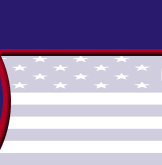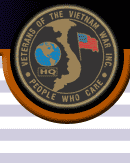




![]()
VVnW National Scholarship Program
Frequently Asked Questions
Educational Links
Suggested Reading
Vietnam War Video Documentation & Suggested Television Series
POW/MIA
War Memorials
Post Traumatic Stress Disorder
Special Articles of Interest
Combat After Action Report 1969
Agent Orange
1. Who were the enemy in Vietnam? A. We fought against the N.V.A. (North Vietnam Army) and the V.C. (Viet Cong). 2. What was the terrain like? A. There were hills, valleys, mountains, jungle, flatlands, rice paddies, rivers and shoreline. 3. What kind of foods did you eat? A. Hot food if lucky the LRRP (long Range Recon Patrol) rations or C rations (meals in a can). 4. Where and what were the tunnels like? A. Tunnels in Vietnam were throughout the country, some small but many large complexes such as in Cu Chi. 5. Did everyone fight in the war? A. Not all soldiers in Vietnam saw combat. Many worked in support jobs, which in some cases was just as important as being in combat. 5. How did you keep in contact with people back home? A. Through the mail, there were a very few of us that had a chance to call once during our tour. 7. How long did you serve in Vietnam? A. Unless you re-enlisted in country and asked to remain, or you were severely wounded, you served a one year tour of duty. 8. What was the climate like? A. For eight months you had extreme heat between 100 and 120 degrees and during the monsoon season for four months you had up to eight inches of rain daily. 9. How long was the Vietnam War? A. 20 years, the longest war in United States history, 1955-1975. 10. Why was the U.S. fighting in Vietnam called a conflict? A. Because Congress never voted to officially declare it a war. 11. What were some of the countries whose soldiers fought alongside the U.S. troops? A. South Vietnam, Australia and the Republic of South Korea. 12. How many Americans died in the war? A. 58,226 including 8 WOMEN. 13. What was the age of the American soldiers? A. Average around 19, but some as young as 17. 14. What were some of the animals and insects in Vietnam? A. Tigers, wart hogs, water buffalos, snakes, rats, leeches, spiders, fire ants, tarantulas and mosquitoes. 15. Did all the soldiers come home from the Vietnam War? A. NO! There are still 2,000 P.O.W. (Prisoners of War) - M.I.A.'s (Missing In Action) who have still NOT come home from the Vietnam War. 16. How many American Soldiers were wounded in the war? A. Approximately 256,000. 17. What was the Domino Principle? A. That if South Vietnam fell to the North Vietnamese Communists all of the other countries in Southeast Asia would eventually become communist. 18. What is Agent Orange? A. A herbicide that was sprayed to defoliate land areas in Vietnam. 19. Did you go to Vietnam with the friends you made in the service? A. In most cases instead of going over in a unit move, we went there as individual soldiers and were assigned to different units when we arrived in country. 20. What was it like coming home? A. When you left Vietnam at the end of your tour of duty, you were sent home on a 2 or 4 week leave. Or if your time was up in the military, you were discharged out. It was very strange being in the jungle one day and the next on your parents porch back home as either a civilian or home on leave. 21. What was the draft system? A. If you were a male, when you turned 18 years old, you would register the draft by mail or by going to your local draft board. This would allow the government to have easy access to ready information on you in the event you would have to be called up to serve in the military. 22. How were you classified in the draft system? A. When you received your draft card, there was a number and or a letter classification on it. This was governed by your physical condition, educational status (student, or not), family situation (single, married, sole provider, or survivor, etc.), and employment status (critical job, etc.). 23. What happened if you were drafted? A. You would serve two years in the military, 99% of the draftees served in the Army, but there was a very small percentage drafted in the Marines. 24. What if you enlisted? A. You would join the branch of service of your choosing, provided they had openings and they would accept you. But you would have to sign up and serve a minimum of three or four years. 25. Once in the military did you get to choose the job you wanted? A. In almost all cases the military would choose your job assignment for you. 26. Were stationed at a Post near your home? A. Most likely not. The military would send you where they wanted, whenever they wanted. 27. What is P.T.S.D. and did it affect Vietnam Veterans? A. POST TRAUMATIC STRESS DISORDER. Simply put, Mental and Physical severe after-affects of the Vietnam War that many Vietnam Vets have, due to their participation in the war. 28. Did every soldier in Vietnam do drugs and what kind? A. Let's start off by saying drugs were used in Vietnam, mostly marijuana. But UNLIKE in most Hollywood Movies about the war, THE VAST MAJORITY OF SOLDIERS DID NOT USE DRUGS! Studies and surveys done by many groups have stated that LESS THAN 10% OF SOLDIERS in Vietnam were casual users. 29. Was there prostitution in Vietnam. A. Yes, there was, but because of a very poor economy, in many instances, women would do this in order to help their children or families to survive. 30. What are Amer-Asian children? A. They would be the biological offspring of American men and Vietnamese women. Thousands of American soldiers children were left behind and are still in Vietnam. Vietnam Order of Battle - Galahad Books - Stanton Vietnam War-Records By John Kolsun Teach Vietnam Lee Benjamin's "Vietnam War History Page Secrets of War - http://www.secretsofwar.com National Park Service Museum Resource Center 'NamTales, by Dave Blackledge - Interesting or funny stories or poems about the weather, insects, animals, friends, etc during Vietnam war tours. Not combat or depressing type stories...not to downplay our combat actions, but the page is for remembering the few good times, or interesting things you learned while serving in Vietnam. RE: Stories since Vietnam A MUST SEE!!! Vietnam: Yesterday and Today Vietnam Veterans Vietnam War Combat Art by Jim Pollock in the U. S. Army Center of Military History (CMH) War Art Collection. Also includes non war paintings, drawings, combat art documents and news articles. http://members.aol.com/jimm844224/vietart1.html WARNING: The files on "The Radio First Termer", contain strong language that some listeners may find offensive. This site is presented only for its historical value and nothing more! Vietnam War Video Documentation & Suggested Television Series Americans Abandoned - American Defense Institute Suggested Television Series China Beach Suggested Movies We Were Soldiers Suggested Plays Miss Saigon
Vietnam the Decisive Battles - Macmillan- Pimlott
Images of a Lengthy War - US Army Center of Military History
The Eyewitness History of VNW - Associated Press
Offerings at the Wall -Turner - Allen
NAM - The Vietnam Experience - Hamly - Page
The American Experience in the V.N. War - Norton - Dougant
Historical Atlas of the V.N. War - Houghtom Mifflin - Summers
The Vietnam Experience )series) - Boston Publishing
The Wall - Collins
We Were Soldiers Once and Young - Random House - Moore
Vietnam War Almanac - Facts on File - Summers
To Heal A Nation - Scruggs - Harper Row Books
A Bright Shinning Lie Random House - Sheeban
The Tunnels of Cu Chi - Random House - Mangold
Charlie Company - Morrow - Goldman
Dear America Letters Home From Vietnam - Norton
Kiss the Boys Goodbye - Dutton - Stevenson
A Life in a Year -Presido - Ebert
Vietnam an American Ordeal - Prentice Hall - Moss
Vietnam a History - Viking - Karnow
The 10,000 Day War - Avon - Maclean
A Time for War - Oxford - Shulzinger
Valley of Decision - Houghton -Prados
Vietnam at War - Oxford - Davidson
The Complet History of the Vietnam War - Brompton
The History of the Vietnam War - Military Press
The Vietnam War - Crown
The Vietnam War Day by Day - Barnes& Noble - Bowman
The Vietnam Story - Chartweel Books - Fowler
Battles and Campaigns in Viet Nam - Military Press - Carhart
The History of the Vietnam War - Galahad Books
Vietnam The History & The Tactics - Cresent
Vietnam War Diary - Military Press
The Vietnam War - Brassey's
Vietnam Images From Combat Photographers - Starwood
Encyclopedia of the Vietnam War - Macmillian U.S.A.
The Vietnam War - Barnes & Noble - Natty
Anatomy of a War - New Press - Kolko
The world Almanac of the Vietnam War - World Almanac
Vietnam at War - Oxford Davidson
TET - DaCapo - OberdonFer
The Vietnam Wars - Harper Perennial - Young
After TET - Vintage - Spector
![]() if you want to learn about or teach Vietnam Check it out! INTERACTIVE SITE
if you want to learn about or teach Vietnam Check it out! INTERACTIVE SITE
(this image may not be used elsewhere)

Museum Resource Center - CHECK IT OUT!
This site contains information on what happens to the articles left at the "WALL".
- Sandra M. Wittman - Professor, Library Services -
Oakton Community College
Skokie, Illinois
(Who are they - Who did they become - Who are they now)
Masters of War, Guerrilla Warfare in V.N. - A&E
Battlefield Vietnam - Time Life Video
Vietnam War in the Jungle - Madacy Entertainment
Vietnam Combat - Marathon Music &Video
Vietnam the 10,000 Day War - BWE Video
Vietnam - CBS News with Walter Cronkite
Vietnam on the Front Lines - The History Channel
The Vietnam War with Mike Wallace - The History Channel
The Anderson Platoon - Home Vision
Bob Hope's, Entertaining the Troops, The Vietnam Years - Guthy Renker Video
We Can Keep You Forever - Lionheart Video
Vietnam a Television History
Tour of Duty
Good Morning Vietnam
A Bright Shining Lie
Gardens of Stone
Veterans of the
"An organization succeeds, not because it is long-established, |



